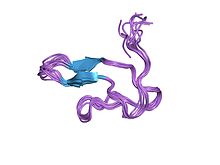Cocaine- and amphetamine-regulated transcript
| CART prepropeptide | |
|---|---|
| Identifiers | |
| Symbol | CARTPT |
| Entrez | 9607 |
| HUGO | 24323 |
| OMIM | 602606 |
| RefSeq | NM_004291 |
| UniProt | Q16568 |
| Other data | |
| Locus | Chr. 5 q13.2 |
| CART | |||||||||
|---|---|---|---|---|---|---|---|---|---|

cocaine- and amphetamine-regulated transcript
|
|||||||||
| Identifiers | |||||||||
| Symbol | CART | ||||||||
| Pfam | PF06373 | ||||||||
| InterPro | IPR009106 | ||||||||
| SCOP | 1hy9 | ||||||||
| SUPERFAMILY | 1hy9 | ||||||||
|
|||||||||
| Available protein structures: | |
|---|---|
| Pfam | structures |
| PDB | RCSB PDB; PDBe; PDBj |
| PDBsum | structure summary |
Cocaine- and amphetamine-regulated transcript, also known as CART, is a protein that in humans is encoded by the CARTPT gene. CART appears to have roles in reward, feeding, and stress, and it has the functional properties of an endogenous psychostimulant.
CART is a neuropeptide that produces similar behaviour in animals to cocaine and amphetamine, but conversely blocks the effects of cocaine when they are co-administered. The peptide is found in several areas, among them the ventral tegmental area (VTA) of the brain. When CART is injected into rat VTA, increased locomotor activity is seen, which is one of the signs of "central stimulation" caused by substances such as cocaine and amphetamine. The rats also tended to return to the place where they had been injected. This is called conditioned place preference and is seen after injection of cocaine.
CART peptides, in particular, CART (55–102), seem to have an important function in the regulation of energy homeostasis, and interact with several hypothalamic appetite circuits. CART expression is regulated by several peripheral peptide hormones involved in appetite regulation, including leptin,cholecystokinin and ghrelin, with CART and cholecystokinin having synergistic effects on appetite regulation.
CART is released in response to repeated dopamine release in the nucleus accumbens, and may regulate the activity of neurons in this area. CART production is upregulated by CREB, a protein thought to be involved with the development of drug addiction, and CART may be an important therapeutic target in the treatment of stimulant abuse.
CART is an anorectic peptide and is widely expressed in both the central and peripheral nervous systems, particularly concentrated in the hypothalamus. CART is outside of the nervous system also expressed in pituitary endocrine cells, adrenomedullary cells, islet somatostatin cells, and in rat antral gastrin cells. Other structures and pathways associated with CART expression include the mesolimbic pathway (linking the ventral tegmental area to the nucleus accumbens) and amygdala.
...
Wikipedia
